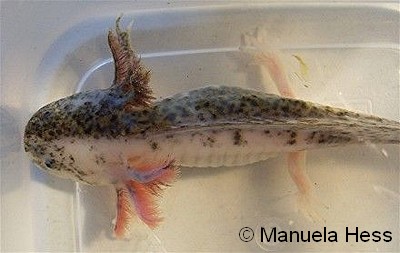Firt, sorry for my english ! But i'm going to try helping you with my informations...
This is not a color but a hybrid concept. The axolotl is not possessing the same genetic code all over his body. Visually a chimaera can show two different colors, one right and one left, and only then we can recognize her.
To be noticed a chimaera is, for example, half albino / half savage, or half leucistic / half wild.
Once adult, the colors can migrate slightly to mix, however the differentiation is often possible on the head. A chymère is a rare accident of nature. It isn't genetically transmitted during reproduction.
Cause and natural hazards causing chimaera "in vivo":
1. Just after fertilization, twin zygotes are formed in the same egg (^we can estimate a 1% chance)
2. It is necessary that the twins migrate against each other in a very primitive stage of development (we can estimate a 1% chance)
3. We need the zygotes to form one with the genes of each (at that stage, the embryo is just a cell's group!)
4. It is necessary that this "graft" is accepted, with the axolotl we can estimated succeed in 100% of cases.
4. We need the development of the embryo to continues normally, without stopping. (estimate 90%)
5. Let the axolotl "half-half" born and grow (as a percentage variable between spawning and rearing conditions, incalculable)
The chances of having a chimaera be about minimum 1 per hundred thousand (1 / 100,000), if we make a rough calculation. (not exactly)
The great capacity of regeneration of the axolotl, and its very good acceptance of transplants are probably something in the fact that there is a little more in the axolotl chymères that elsewhere.







